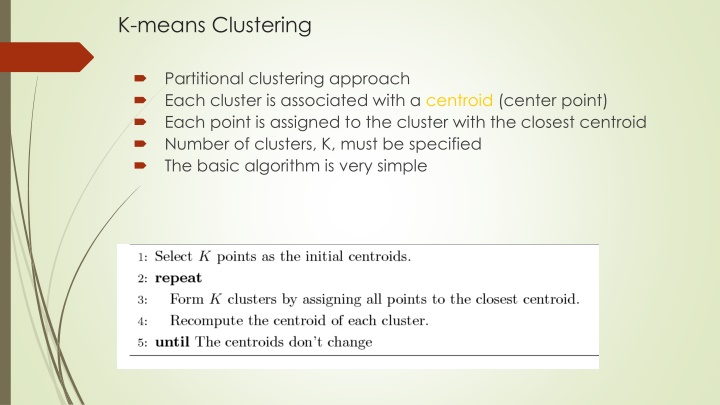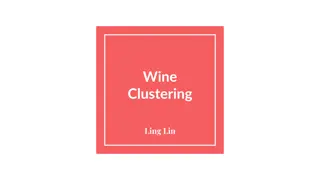
K-Means Clustering: A Simple Partitional Approach
K-means clustering is a fundamental partitional clustering method where each cluster is associated with a centroid and each point is assigned to the cluster with the nearest centroid. This algorithm requires specifying the number of clusters (K) and choosing initial centroids, which can impact the clustering results. The process involves iterating to group data points based on similarity measures until convergence is achieved. Check out the importance of choosing initial centroids and how it affects the clustering outcome.
Download Presentation

Please find below an Image/Link to download the presentation.
The content on the website is provided AS IS for your information and personal use only. It may not be sold, licensed, or shared on other websites without obtaining consent from the author. If you encounter any issues during the download, it is possible that the publisher has removed the file from their server.
You are allowed to download the files provided on this website for personal or commercial use, subject to the condition that they are used lawfully. All files are the property of their respective owners.
The content on the website is provided AS IS for your information and personal use only. It may not be sold, licensed, or shared on other websites without obtaining consent from the author.
E N D
Presentation Transcript
K-means Clustering Partitional clustering approach Each cluster is associated with a centroid (center point) Each point is assigned to the cluster with the closest centroid Number of clusters, K, must be specified The basic algorithm is very simple
K-means Clustering Details Initial centroids are often chosen randomly. Clusters produced vary from one run to another. The centroid is (typically) the mean of the points in the cluster. Closeness is measured by Euclidean distance, cosine similarity, correlation, etc. K-means will converge for common similarity measures mentioned above. Most of the convergence happens in the first few iterations. Often the stopping condition is changed to Until relatively few points change clusters Complexity is O( n * K * I * d ) n = number of points, K = number of clusters, I = number of iterations, d = number of attributes
Two different K-means Clusterings 3 2.5 Original Points 2 1.5 y 1 0.5 0 -2 -1.5 -1 -0.5 0 0.5 1 1.5 2 x 3 3 2.5 2.5 2 2 1.5 1.5 y y 1 1 0.5 0.5 0 0 -2 -1.5 -1 -0.5 0 0.5 1 1.5 2 -2 -1.5 -1 -0.5 0 0.5 1 1.5 2 x x Optimal Clustering Sub-optimal Clustering
Importance of Choosing Initial Centroids Iteration 1 Iteration 2 Iteration 3 Iteration 4 Iteration 5 Iteration 6 3 3 3 3 3 3 2.5 2.5 2.5 2.5 2.5 2.5 2 2 2 2 2 2 1.5 1.5 1.5 1.5 1.5 1.5 y y y y y y 1 1 1 1 1 1 0.5 0.5 0.5 0.5 0.5 0.5 0 0 0 0 0 0 -2 -2 -2 -2 -2 -2 -1.5 -1.5 -1.5 -1.5 -1.5 -1.5 -1 -1 -1 -1 -1 -1 -0.5 -0.5 -0.5 -0.5 -0.5 -0.5 0 0 0 0 0 0 0.5 0.5 0.5 0.5 0.5 0.5 1 1 1 1 1 1 1.5 1.5 1.5 1.5 1.5 1.5 2 2 2 2 2 2 x x x x x x
Importance of Choosing Initial Centroids Iteration 1 Iteration 2 Iteration 3 3 3 3 2.5 2.5 2.5 2 2 2 1.5 1.5 1.5 y y y 1 1 1 0.5 0.5 0.5 0 0 0 -2 -1.5 -1 -0.5 0 0.5 1 1.5 2 -2 -1.5 -1 -0.5 0 0.5 1 1.5 2 -2 -1.5 -1 -0.5 0 0.5 1 1.5 2 x x x Iteration 4 Iteration 5 Iteration 6 3 3 3 2.5 2.5 2.5 2 2 2 1.5 1.5 1.5 y y y 1 1 1 0.5 0.5 0.5 0 0 0 -2 -1.5 -1 -0.5 0 0.5 1 1.5 2 -2 -1.5 -1 -0.5 0 0.5 1 1.5 2 -2 -1.5 -1 -0.5 0 0.5 1 1.5 2 x x x
Importance of Choosing Initial Centroids Iteration 1 Iteration 2 Iteration 3 Iteration 4 Iteration 5 3 3 3 3 3 2.5 2.5 2.5 2.5 2.5 2 2 2 2 2 1.5 1.5 1.5 1.5 1.5 y y y y y 1 1 1 1 1 0.5 0.5 0.5 0.5 0.5 0 0 0 0 0 -2 -2 -2 -2 -2 -1.5 -1.5 -1.5 -1.5 -1.5 -1 -1 -1 -1 -1 -0.5 -0.5 -0.5 -0.5 -0.5 0 0 0 0 0 0.5 0.5 0.5 0.5 0.5 1 1 1 1 1 1.5 1.5 1.5 1.5 1.5 2 2 2 2 2 x x x x x
Importance of Choosing Initial Centroids Iteration 1 Iteration 2 3 3 2.5 2.5 2 2 1.5 1.5 y y 1 1 0.5 0.5 0 0 -2 -1.5 -1 -0.5 0 0.5 1 1.5 2 -2 -1.5 -1 -0.5 0 0.5 1 1.5 2 x x Iteration 3 Iteration 4 Iteration 5 3 3 3 2.5 2.5 2.5 2 2 2 1.5 1.5 1.5 y y y 1 1 1 0.5 0.5 0.5 0 0 0 -2 -1.5 -1 -0.5 0 0.5 1 1.5 2 -2 -1.5 -1 -0.5 0 0.5 1 1.5 2 -2 -1.5 -1 -0.5 0 0.5 1 1.5 2 x x x
Problems with Selecting Initial Points If there are K real clusters then the chance of selecting one centroid from each cluster is small. Chance is relatively small when K is large If clusters are the same size, n, then For example, if K = 10, then probability = 10!/1010 = 0.00036 Sometimes the initial centroids will readjust themselves in right way, and sometimes they don t Consider an example of five pairs of clusters
10 Clusters Example Iteration 1 Iteration 2 Iteration 3 Iteration 4 8 8 8 8 6 6 6 6 4 4 4 4 2 2 2 2 y y y y 0 0 0 0 -2 -2 -2 -2 -4 -4 -4 -4 -6 -6 -6 -6 0 0 0 0 5 5 5 5 10 x x x x 10 10 10 15 15 15 15 20 20 20 20 Starting with two initial centroids in one cluster of each pair of clusters
10 Clusters Example Iteration 1 Iteration 2 8 8 6 6 4 4 2 2 y y 0 0 -2 -2 -4 -4 -6 -6 0 5 10 x 15 20 0 5 10 x 15 20 Iteration 3 Iteration 4 8 8 6 6 4 4 2 2 y y 0 0 -2 -2 -4 -4 -6 -6 0 5 10 x 15 20 0 5 10 x 15 20 Starting with two initial centroids in one cluster of each pair of clusters
10 Clusters Example Iteration 1 Iteration 2 Iteration 3 Iteration 4 8 8 8 8 6 6 6 6 4 4 4 4 2 2 2 2 y y y y 0 0 0 0 -2 -2 -2 -2 -4 -4 -4 -4 -6 -6 -6 -6 0 0 0 0 5 5 5 5 10 x x x x 10 10 10 15 15 15 15 20 20 20 20 Starting with some pairs of clusters having three initial centroids, while other have only one.
10 Clusters Example Iteration 1 Iteration 2 8 8 6 6 4 4 2 2 y y 0 0 -2 -2 -4 -4 -6 -6 0 5 10 x 15 20 0 5 10 x 15 20 Iteration 3 Iteration 4 8 8 6 6 4 4 2 2 y y 0 0 -2 -2 -4 -4 -6 -6 0 5 10 x 15 20 0 5 10 x 15 20 Starting with some pairs of clusters having three initial centroids, while other have only one.
Solutions to Initial Centroids Problem Multiple runs Helps, but probability is not on your side Sample and use hierarchical clustering to determine initial centroids Select more than k initial centroids and then select among these initial centroids Select most widely separated Postprocessing Bisecting K-means Not as susceptible to initialization issues
Handling Empty Clusters Basic K-means algorithm can yield empty clusters Several strategies Choose the point that contributes most to SSE Choose a point from the cluster with the highest SSE If there are several empty clusters, the above can be repeated several times.
Updating Centers Incrementally In the basic K-means algorithm, centroids are updated after all points are assigned to a centroid An alternative is to update the centroids after each assignment (incremental approach) Each assignment updates zero or two centroids More expensive Introduces an order dependency Never get an empty cluster Can use weights to change the impact
Pre-processing and Post-processing Pre-processing Normalize the data Eliminate outliers Post-processing Eliminate small clusters that may represent outliers Split loose clusters, i.e., clusters with relatively high SSE Merge clusters that are close and that have relatively low SSE Can use these steps during the clustering process ISODATA
Bisecting K-means Bisecting K-means algorithm Variant of K-means that can produce a partitional or a hierarchical clustering

